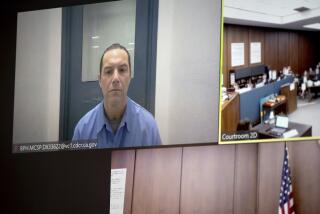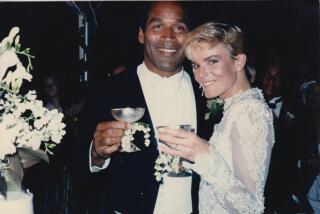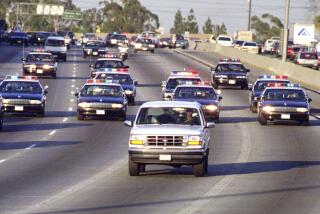DNA Expert Testifies That Blood Evidence Points to Simpson
- Share via
Posting one incriminating statistic after another on a huge display board, a DNA expert testified Wednesday that O.J. Simpson’s blood contains the same genetic markers as those found in a trail of droplets leading away from the bodies of Nicole Brown Simpson and Ronald Lyle Goldman.
Fewer than 1 in 170 million people could have been the source for one particular drop, which contained enough DNA to run an especially sophisticated test, said Robin Cotton, director of the Cellmark Diagnostic Laboratory in Maryland. Simpson fit that profile. Other drops, examined with less sensitive probes, could have been produced by as many as one in 5,200 people--again including Simpson, Cotton said.
The defense has suggested that the blood drops were tampered with or contaminated in the Los Angeles Police Department lab.
Before presenting the DNA test results, Cotton ran through a brisk lesson in genetics. The plaintiffs kept the presentation short and focused, with a minimum of jargon. In contrast, prosecutors in Simpson’s criminal trial had questioned Cotton for four days before getting to the statistics linking the defendant to the slashings.
Cotton’s brief DNA seminar seemed to hold the attention of jurors, who watched intently, nodding at times, as she acquainted them with terms like DQ-alpha and autorad. Most scribbled notes nonstop when she plunged into the DNA test results.
The jurors appeared equally interested in the first witness to take the stand Wednesday: FBI Special Agent Douglas W. Deedrick.
Deedrick testified that trace evidence, including hair fragments and carpet fibers, could link Simpson to the slayings--but the judge stopped him in the middle of explaining just how rare some of those fibers are.
Plaintiffs’ attorneys had hoped to prove to jurors that Simpson’s white Ford Bronco was one of just a very few cars sold in Los Angeles County before the killings that contained the kind of mocha-colored carpet fibers discovered on a bloody glove at Simpson’s estate and on a knit cap at the crime scene. The defense, however, objected to the analysis. And Superior Court Judge Hiroshi Fujisaki backed them up. “What is the relevance of all this?” he complained. “I don’t see the relevance.”
So instead of hearing specific Los Angeles County statistics, jurors were left with more general information--that the carpet fibers in question had been used in about 72,000 Ford vehicles, including not only Broncos, but also F-series trucks and Econoline vans.
In cross-examination, defense attorney Daniel Leonard sought to portray Deedrick as a biased advocate working in a fuzzy and highly subjective field. He accused Deedrick of shading his testimony and trying to fool the jurors. And he got Deedrick to acknowledge that he displays a framed photo of Goldman’s father and sister in his FBI office.
But Leonard’s strenuous efforts to attack the agent did not seem to impress many jurors. At least two jammed their pens into the spiral binding of their notebooks shortly after Leonard took the podium, apparently figuring they would not need to take many notes. Others jotted down just a phrase or two during the cross-examination.
Deedrick did concede that hair analysis is subjective and that even trained observers can reach different conclusions. But he pointed out that a defense expert had looked at the hair and fiber evidence in the Simpson case and reached the same conclusions he had.
Deedrick also stood firm when Leonard sought to challenge his testimony that hairs matching O.J. Simpson’s were found on the knit cap and on Goldman’s blood-drenched shirt.
He agreed with Leonard that Simpson’s hairs could have been lying around the crime scene long before the slayings, and could have drifted onto the cap and shirt through a wholly innocent transfer. Yet he insisted that the flying-debris scenario was not the most plausible explanation, especially because some of the hairs were intertwined in the fibers of the knit cap. “It’s not logical to me,” Deedrick concluded.
More to Read
Sign up for Essential California
The most important California stories and recommendations in your inbox every morning.
You may occasionally receive promotional content from the Los Angeles Times.













